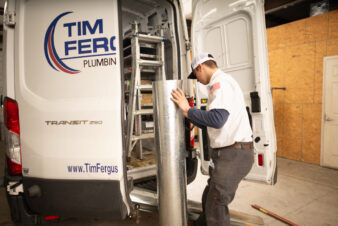
Okay, I admit, the headline is a wee-bit dramatic, but I hope to bring it all full circle.
Recently, I had the opportunity to participate in discussion with the “Get the Lead Out Plumbing Consortium” as they talked about the impact of the impending national “Reduction of Lead in Drinking Water Act” on the plumbing industry. This new legislation, which goes into effect January 14, 2014, will reduce the permissible levels of lead in pipe, fittings and fixtures for potable water to a weighted average less than or equal to 0.25 percent from the current national standard of a 0.8 percent maximum.
My question to you is: Are you aware of this? What are you going to do about this? How does this affect your business, if at all? There is just a little more than a year for this law to go into action. And there are legal implications. According to www.weareleadfree.net, a Watts Water Technologies website dedicated to the subject of lead free, there are ramifications:
• States responsible for enforcement through state or local plumbing codes or other appropriate means
• Illegal to introduce into commerce or install any potable water product that does not comply
• Non-compliance may result in fines, installed product removal costs, lawsuits by private parties or government agency.
I have heard from some contractor friends that they will leave the lead free to the manufacturers and they will continue to buy what is offered from their local wholesaler. So the onus is laid squarely on the shoulders of wholesalers and manufacturers? I know first-hand that manufacturers are making the necessary, albeit substantial investments to comply with this lead free legislation.
But there are some questions and issues that still confront contractors.
1. Enforcement — States and local jurisdictions will have the authority to enforce, even assess fines. Is this going to be through plumbing inspectors? Will the lead free fixtures be clearly designated with proper markings so contractors know that the fixtures they are installing are, in fact, lead free?
2. Wholesaler Inventory — What is to be done with the enormous inventory of “leaded” fixtures on wholesaler shelves? To my knowledge, the product is not recyclable. And, will there be some sort of “grandfathering” in of certain installations?
3. Training — Training is paramount in every aspect of a contractor’s education. Where do contractors go for training on lead free?
4. Manufacturer Changeover — Manufacturers are making a huge commitment to comply with this legislation. Some still will offer lines that offer “leaded” fixtures to apply to non-potable applications such as heating and hydronics installations. And with large investments may come price increases.
5. Double Standard — The lead free law by all accounts is a good thing for the “health of the nation.” But there isn’t any legislation for the existing water lines that come into an existing home or commercial building. Doesn’t that sort of defeat the purpose? And what about retrofits? Can certain existing fixtures stay in place if certain renovations or installations are added? What about outdoor fixtures such as hose spigots. Again, to my knowledge, the new legislation does not apply.
Oh yeah, lead free or die. The state of New Hampshire’s motto is Live Free Or Die. I recently visited Franklin, N.H. where Watts Water Technologies broke ground on a multimillion dollar, 30,000-square-foot expansion to its exisiting Facility, which produces products for many of its brands. The expansion will bring in new jobs and increased capacity to meet federal Lead Free guidelines. The expansion reflects the company’s commitment to proactively meet the requirements of the lead free legislation. It will enable the company to expand its foundry capabilities, and achieve its goal to provide additional Lead Free products to the market ahead of the 2014 law.
But I’d love to know how all of this affects you, the contractor, the wholesaler or the manufacturer.
Thoughts?




Join the conversation: